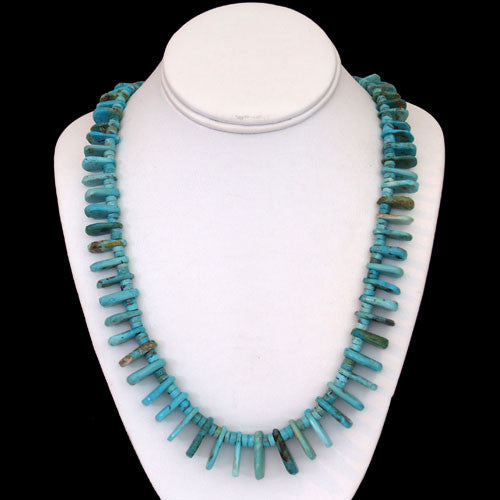




Santo Domingo Handmade Natural Gem Grade White-horse Nevada Turquoise Tab Necklace - Ray Lovato (#144)
$1,250.00
Artist: Ray Lovato
Length: 30"
Largest tab: .43" x .87"
Ray Lovato is to tab turquoise necklaces what Barry and Steve are to Twin Rocks, inseparable. I know that is a shameless comparison, but I can’t help it. We can’t get out of the post and Ray cannot stop making beads. So there we are! This tab necklace features the best of Ray’s work. Made with Whitehorse turquoise from Nevada, it is appropriate for traditional or contemporary celebrations.
Fox Turquoise
Fox turquoise jewelry has been a part of fine Native American turquoise jewelry for decades. The Fox mine has probably produced more turquoise than all the other mines in the state put together; a conservative estimate of the total production has been put "not less than 500,000 pounds." For years the mine produced more than 2,000 pounds of turquoise a month. The bulk of Fox turquoise is only a fair quality, being deficient in color, but is quite hard and excellently suited to artificial coloring. For this purpose, most of the mine production for years was sold to factories in Idar-Oberstein, Germany. Much excellent ore was, however, processed in the United States.
The Fox turquoise mine is in a faulted, argillized block of chert in which the beds strike predominantly N. 60-degrees E. and dip about 45 degrees SE. Pseudomorphs of limonite after pyrite attest to the former presence of pyrite in the argillized zone. Greenish and blue turquoise occur in silicified, limonite veinlets that follow the bedding. Smaller veinlets form flat-lying units in the chert.
George Schmidtlein visited the deposit about 1910 or 1912; the location of the Fox mine was revealed to Schmidtlein by a servant in his household. The Indians had known it for centuries and almost everyone in the vicinity had some of the turquoise in one form or another. In 1912 Schmidtlein and his wife made a trip east, taking some of the turquoise to the C. D. Peacock Jewelry Co., in Chicago. Peacock agreed that Fox turquoise was "very pretty," but knew of no market for it, so Schmidtlein dropped the matter.
In 1914, Charles Schmidtlein, son of George, and Johnnie Francis filed an official notice of location on the property under the name of "Fox Lode Mining Claim." Other mines had been developed in Nevada at the time, and a definite market for the ore had been established. Schmidtlein and Francis worked the claim until they had established its value and, in 1915 sold the property to William R. McGaw for $3000.00.
McGaw put a crew of miners to work extending the development. The Fox turquoise mine has been developed as an open cut. Another cut was opened along the face of the vein and production expanded. Following the death of McGaw, Edward C. Smith, a relative, assumed management of the mine. When Smith died, his son Charles E. Smith became manager.
In the 1940's, Dowell Ward purchased the old Cortez claims and developed them using the names Fox, White Horse, Green Tree and Smith to differentiate among the colors produced in the area and to create a larger perceived share of the turquoise market. The area produces a huge amount of good quality green or blue-green turquoise with a distinctive matrix. The story is told that during the time he owned the claims, Dowell Ward, amassed one of the largest collections of rough turquoise ever. Dowell's widow Faye is now in possession of the collection and the claims.
The turquoise was found in nodules of all sizes; hundreds were as large as a man’s fist, many even larger. The Fox mine is also known for the sea foam type of nuggets and blue green kind of bubbly material it produces. It is often left in its "nugget" rough state and slightly polished for that appearance. The mine is being worked again and this is new material. The color ranges from blue/green to a dark blue. The material is solid and hard (for turquoise) and cuts well. The rough is almost all nuggets.
The largest true-blue nugget without matrix inclusions found at the Fox turquoise mine weighed slightly more than one pound, (a troy weight pound is about 1,866 carats) and was presented to the Smithsonian Institution in Washington, D.C. Another huge nugget, almost as large, was presented to Tiffany & Co., New York City. Mrs. Clara L. McGaw had a nugget, which weighed about one pound but this had a slight amount of matrix in it.
Fox Mine; Nevada, Lander County, Bullion District. The Cortez or Fox turquoise mine is in the bottom of a canyon in the NE1/4, sec. 34, T. 27N, R. 47 E. about 1.5 miles southwest from the mouth of Cortez Canyon. The mine is accessible over a well-graded road.
About the artist:
The gift of humor is a blessing to those who have it, and to those of us exposed to the comic. From an early age, Steve and I have been blessed with the humor of Santa Domingo artist Ray Lovato. Not only does Ray create exceptional jewelry, he does it with wit and comedy. He always has an aura of happiness around him, and this attitude seems to spread, like a California fog, to those who know him. In addition to his artistic talents, Ray is also a gifted salesman. When he pulls up in front of the trading post we know that there is a good possibility that we will soon be parting company with our available cash.
Related legends:
Precious Stones
Turquoise; Precious stones have symbolic implications. For example, turquoise if a "collective term for all the precious stones, wealth, or mixed offerings. Good fortune is attributed to this stone." Both white shell and turquoise are emphasized in Kinaalda? More about this legend
